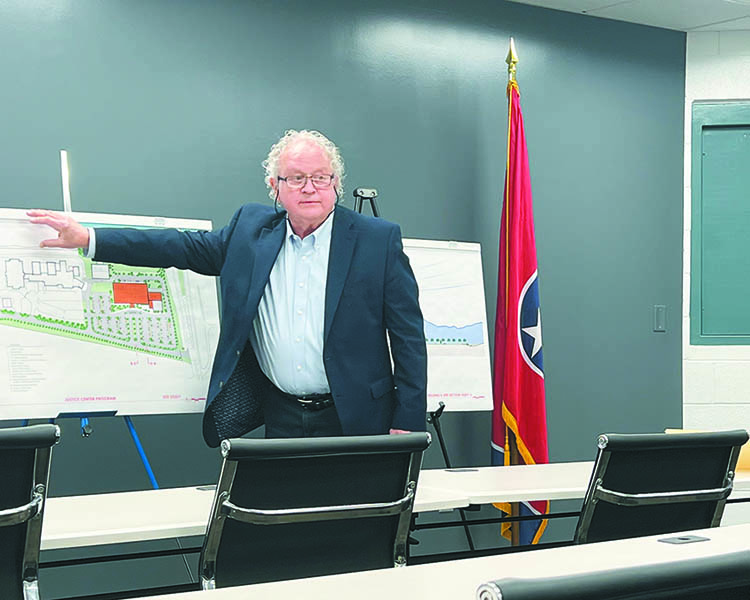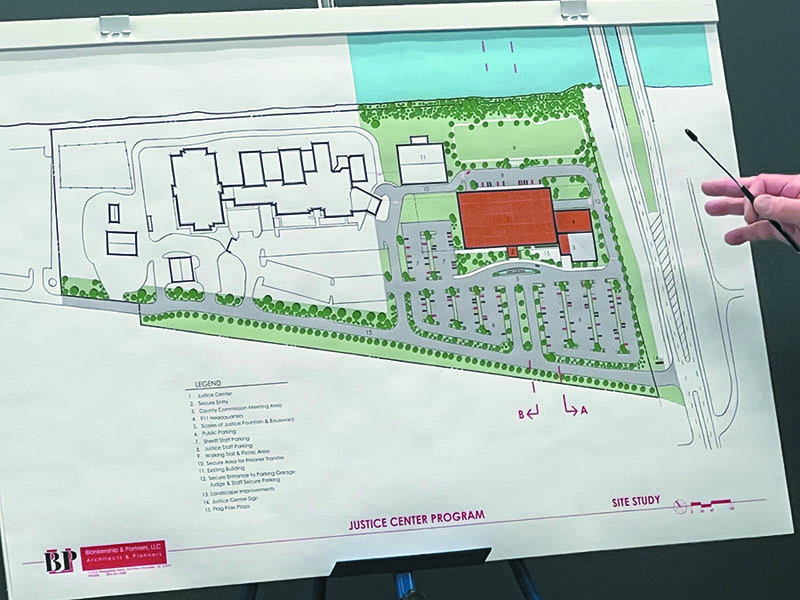The high cost of ‘Justice’
Committee sees plans for all-in-one ‘Justice Center’
Anderson County could be on its way to building a new combined “Justice Center” that would concentrate most courts and law-enforcement activities into a single location.
It would be built adjacent to the county’s Detention Center along North Charles G. Seivers Boulevard at the Clinch River.
The center, estimated to cost at least $30 million and possibly as much as $50 million, would house county Circuit, Chancery, Juvenile and (north) General Sessions courts, along with the district attorney general, county law director, and Sheriff’s Office.
It would also eliminate transportation of prisoners from the Detention Center to downtown Clinton for court appearances, as there would be a secure, enclosed walkway from the jail to the Justice Center. There also would be a secure elevator for prisoners that would not be accessible by the general public.
There would also be a secure parking are for judges and other court officials.
Not included at that location would be the General Sessions Court division in Oak Ridge, which would remain where it is.
Knoxville architect Bill Blankenship and his associate Illabelle Lee presented their initial plans for the 110,000-115,000-square-foot complex to the Anderson County Commission’s Justice Center-Magistrates Committee during a meeting last Thursday (Jan. 4) at the detention center.
Blankenship and Lee have been working on the plans for about two years, and last week’s meeting was the first for the committee since that work began.
Their work has already cost the county about $250,000, it was noted by County Commission Chairman Tyler Mayes during the meeting.
The conceptual drawings show the Justice Center in the space between the detention center (county jail) and Seivers Boulevard, on the south side of the Clinch River, where soccer fields are now located. Anderson County already owns the property.
Anderson County Mayor Terry Frank, who was among attendees at the meeting, said she had floated the idea of the combined center to put courts and associated functions in one place for more efficiency and lower operating costs.
“It makes sense to consolidate facilities, and stop funding duplication of services,” Frank told The Courier News.
She noted that having Juvenile Court in the Robert Jolly Building across the street from the county courthouse requires having “a whole different set of bailiffs, security people and scanners” for both buildings.
The savings on personnel could help justify the cost of the combined center, she said.
“I haven’t put anything together yet, but I said from the beginning that we would need to put together a proposal that outlines the savings we would have,” Frank said.
While some involved in county government believe that building a consolidated justice facility would require a tax increase, Frank was adamant that she would not support the move if higher taxes were needed to pay for it.
“I’m not going to advocate for something that’s going to require a tax increase,” Frank said
Commissioner Joshua Anderson, who served as chairman of the County Commission for the past four years until he stepped down recently, told The Courier News that he’s reluctant to support a project that would cost the taxpayers more money.
“To me, the big thing is that it’s probably going to cost $50 million before it’s through, and I think it’s going to be a hard sell to the general public,” Anderson said.
He said he could see the county considering an increase in property taxes or even introduction of a wheel tax to pay for the center, and he’s against either idea.
“I’m not categorically opposed, but it may be hard to justify the price tag,” Anderson said. “Having to totally relocate courts and infrastructure is going to be a lot more than they realize, and I believe it will have to be financed.”
Circuit Court Clerk Rex Lynch told The Courier News on Monday that he has reservations about the need for and costs of the new center.
“One concern I’ve got, leaving the Oak Ridge court in place means we still have (prisoner) transportation issues,” he said. “To eliminate transportation costs, not moving Oak Ridge would defeat the purpose.”
But, he added, “If it doesn’t cause a tax increase, and makes the courts more efficient, who wouldn’t be in favor of it?”
Frank said she believes that a chunk of the money could come from the sale of the Jolly Building, which now houses Juvenile Court, the Sheriff’s Office, the Anderson County Schools offices, and the District Attorney General’s Office. Also, she said, money the county should receive from the state’s lawsuit against drug manufacturers who make and distribute opiates could be used.
“There will be no new fees or taxes on the citizens,” she said. “I think we can do it, and I hope to come up with some options. If no one agrees, I’m moving on to other things.”
She also said taking the courts out of the present courthouse could eliminate the tight security there now, which forces everyone to pass through scanners no matter where they go in the building.
“Maybe we could put the schools back on the third floor where they used to be,” she said. “It wouldn’t require the same level of security that the courts require.” It would be nice to have a building that’s not in full court-security mode.”
Attendees at the presentation last week included most of the judges in the county, all of whom were expected to give their input on the project during the planning stages, and as it moves forward, Blankenship said.
The next move will be to present the plans to the County Commission’s Operations Committee, Anderson said.



